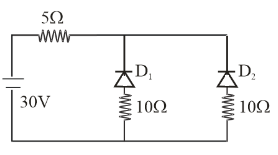
Calculate the current through the given circuit (the diodes are ideal)

(A) 6A
(B) 12A
(C) 1As
(D) 2A

Answer
532.5k+ views
Hint: For solving the circuit diagram first we use the biasing of diode i.e. if the diode is reversed biased then there is no current flow in the circuit. If the diode is forward biased then there is current flow in the circuit. If resistance are in series then total resistance is ${R_1} + {R_2} + ....$. After then applying ohm’s law we will get the value of current flowing in the circuit.
Complete step by step answer:
In the circuit diagram, we can sec ${D_1}$ is reversed biased that means there are no current flow through ${D_1}$
${D_2}$ is forward biased that means there are current flow through ${D_2}$
So the total resistance of the circuit is
${R_L} + {R_{{D_2}}}$
$\Rightarrow{T_{total}} = 5 + 10$
$\Rightarrow{R_{total}} = 15\Omega $
We know according to ohm’s law current through the circuit
$I = \dfrac{v}{r}$
Given that $v = 30\,V$
${R_{total}} = 15\Omega $
So, $I = \dfrac{{30}}{{15}}$
$\therefore I = 2\,A$
Hence option D is correct.
Note: Forward biasing means p part of p-n junction diode is connected to $ + ve$ terminal of battery and $ - ve$ terminal to n junction. Reverse biasing means p terminal is connected to $ - ve$ terminal and n junction is connected to $ + ve$ terminal of battery
Complete step by step answer:
In the circuit diagram, we can sec ${D_1}$ is reversed biased that means there are no current flow through ${D_1}$
${D_2}$ is forward biased that means there are current flow through ${D_2}$
So the total resistance of the circuit is
${R_L} + {R_{{D_2}}}$
$\Rightarrow{T_{total}} = 5 + 10$
$\Rightarrow{R_{total}} = 15\Omega $
We know according to ohm’s law current through the circuit
$I = \dfrac{v}{r}$
Given that $v = 30\,V$
${R_{total}} = 15\Omega $
So, $I = \dfrac{{30}}{{15}}$
$\therefore I = 2\,A$
Hence option D is correct.
Note: Forward biasing means p part of p-n junction diode is connected to $ + ve$ terminal of battery and $ - ve$ terminal to n junction. Reverse biasing means p terminal is connected to $ - ve$ terminal and n junction is connected to $ + ve$ terminal of battery
Recently Updated Pages
Why is there a time difference of about 5 hours between class 10 social science CBSE

Master Class 12 Social Science: Engaging Questions & Answers for Success

Master Class 12 Physics: Engaging Questions & Answers for Success

Master Class 12 Maths: Engaging Questions & Answers for Success

Master Class 12 Economics: Engaging Questions & Answers for Success

Master Class 12 Chemistry: Engaging Questions & Answers for Success

Trending doubts
What are the major means of transport Explain each class 12 social science CBSE

Which are the Top 10 Largest Countries of the World?

Draw a labelled sketch of the human eye class 12 physics CBSE

How much time does it take to bleed after eating p class 12 biology CBSE

Explain sex determination in humans with line diag class 12 biology CBSE

Explain sex determination in humans with the help of class 12 biology CBSE




